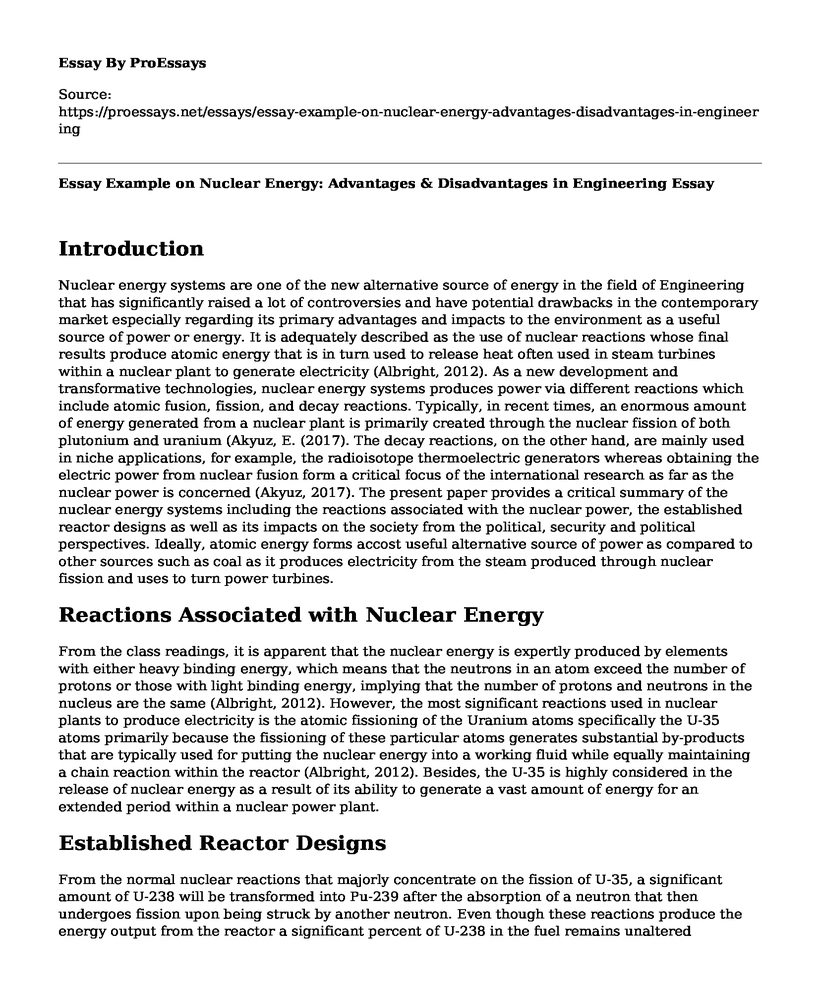Introduction
Nuclear energy systems are one of the new alternative source of energy in the field of Engineering that has significantly raised a lot of controversies and have potential drawbacks in the contemporary market especially regarding its primary advantages and impacts to the environment as a useful source of power or energy. It is adequately described as the use of nuclear reactions whose final results produce atomic energy that is in turn used to release heat often used in steam turbines within a nuclear plant to generate electricity (Albright, 2012). As a new development and transformative technologies, nuclear energy systems produces power via different reactions which include atomic fusion, fission, and decay reactions. Typically, in recent times, an enormous amount of energy generated from a nuclear plant is primarily created through the nuclear fission of both plutonium and uranium (Akyuz, E. (2017). The decay reactions, on the other hand, are mainly used in niche applications, for example, the radioisotope thermoelectric generators whereas obtaining the electric power from nuclear fusion form a critical focus of the international research as far as the nuclear power is concerned (Akyuz, 2017). The present paper provides a critical summary of the nuclear energy systems including the reactions associated with the nuclear power, the established reactor designs as well as its impacts on the society from the political, security and political perspectives. Ideally, atomic energy forms accost useful alternative source of power as compared to other sources such as coal as it produces electricity from the steam produced through nuclear fission and uses to turn power turbines.
Reactions Associated with Nuclear Energy
From the class readings, it is apparent that the nuclear energy is expertly produced by elements with either heavy binding energy, which means that the neutrons in an atom exceed the number of protons or those with light binding energy, implying that the number of protons and neutrons in the nucleus are the same (Albright, 2012). However, the most significant reactions used in nuclear plants to produce electricity is the atomic fissioning of the Uranium atoms specifically the U-35 atoms primarily because the fissioning of these particular atoms generates substantial by-products that are typically used for putting the nuclear energy into a working fluid while equally maintaining a chain reaction within the reactor (Albright, 2012). Besides, the U-35 is highly considered in the release of nuclear energy as a result of its ability to generate a vast amount of energy for an extended period within a nuclear power plant.
Established Reactor Designs
From the normal nuclear reactions that majorly concentrate on the fission of U-35, a significant amount of U-238 will be transformed into Pu-239 after the absorption of a neutron that then undergoes fission upon being struck by another neutron. Even though these reactions produce the energy output from the reactor a significant percent of U-238 in the fuel remains unaltered (Albright, 2012). This reaction can, however, be designed differently or instead a different design reactor is used where only U-238 is used by ensuring a higher amount of neutrons on the order of 105 to 106 eV.
Nuclear Energy and Society
Over the past few decades, nuclear energy has enormously been perceived as an excellent source of energy that has significantly raised a lot of new and challenging concerns within the various aspects of society. Nuclear power as a large-scale attempt to use other sources of energy apart from the dominant fossil fuels has efficiently helped in the eradication of the devastating effects of fossil fuels on the environment (Albright, 2012). In essence, nuclear energy has become one of the largest sources of nonfossil power across the globe after the hydroelectric power. As a significant contribution of the atomic energy, it has played a substantial role in reducing the ever-growing concern of global climate change mainly because the majority of other sources of energy produce power from the combustion of fossil fuels, which releases the harmful greenhouse gases to the environment (Albright, 2012). As a result of the nuclear energy ability to reduce the effects of CO2 intensity on the environment other aspects of the society such as the economy and food security have also benefited.
References
Albright, L. (2012). Chapter 8: Energy Systems Engineering: Evaluation and Implementation. McGraw-Hill Professional.
Akyuz, E. (2017). Advantages and Disadvantages of Nuclear Energy in Turkey: Public Perception. Eurasian Journal of Environmental Research, 1(1), 1-11.
Cite this page
Essay Example on Nuclear Energy: Advantages & Disadvantages in Engineering. (2022, Dec 29). Retrieved from https://proessays.net/essays/essay-example-on-nuclear-energy-advantages-disadvantages-in-engineering
If you are the original author of this essay and no longer wish to have it published on the ProEssays website, please click below to request its removal:
- Strategic and Financial Performance and Position of Gamuda Berhad, a Malaysian Engineering Company
- Essay Sample on British Petroleum Oil Spills
- What Is Disruptive Innovation? Essay Example
- The Mobile Phone Bible Is Now Replacing the Book Bible Paper Example
- New Media, Human Development and Right to Privacy Essay
- Harnessing the Hurricane Energy Essay
- Paper Example on Technological Innovation: Transforming Lives and Shaping the Future







